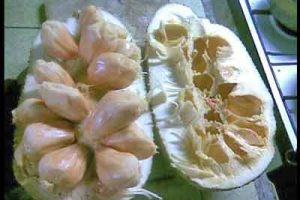Artocarpus integer
Chempedak, small jackfruit
Origin
Indigenous to South east Asia and now distributed elsewhere in the tropics.
Climate
Chempedak is found in equatorial regions from sea level up to 800m. It can withstand temperature extremes of 5 and 40°C and is well-adapted to climates without a dry season and rainfall of 1200-2500mm pa.
Plant Description
It is a deciduous, laticiferous tropical understory tree, 10-25m tall in its native habitat, often with tri-lobed dark green leaves when young but un-lobed and elliptic when mature. Brown hairs on twigs and leaves distinguish it from jackfruit.
Relatives
Moraceae Family. Close relatives include jackfruit, breadfruit, kwai muk, lakoocha and marang.
Soils
Soil type is not critical as long as it is moist and well-drained.
Propagation
The recalcitrant seeds have traditionally been the major means of propagation. Increasingly, seedlings can be used as self-rootstocks for superior mature scion material, which will reduce tree size, the juvenility period and also give fruit with known qualities. The copious latex produced by many Artocarpus species can make grafting troublesome.
Cultivars
Chempedak hybridises very easily with jackfruit, and one such hybrid with smaller fruit (2.5kg) than either is called Cheena. Malaysian and Indonesian government agencies have developed many superior cultivars, but to date these have not been widely distributed elsewhere.
Flowering and Pollination
Flowering is solitary and monoecious, with males occurring as cylindrical spikes, 3-5cm long and females being more rounded. Staminate flowers are usually located towards the periphery of the canopy while pistillate flowers are cauliflorous on the stem and older branches. Nocturnal insects are attracted to the sticky pollen on the former and then to the proteinrich fluid on the latter.
Cultivation
Mature trees need 2-3 kg of NPK plus Mg twice a year.
Wind Tolerance
Not known.
Pruning
Apart from removing dead wood, pruning is mainly aimed at controlling tree height preferably to 3-5m.
The Fruit
The large cylindrical syncarp fruits which can be more than 30cm long and 0.4 – 3.5kg, have a deep yellow, sweet, aromatic flesh that encloses the numerous brown seeds. Some people find the smell of ripe chempedak as objectionable as durian. The blunt, spiny and rubbery rind changes to a golden-brown when ripe.
Fruit Production and Harvesting
Seedling trees have a juvenile period of 3-6 years whereas for grafted plants it is much less. One third of fruit may be self-thinned 1-2 months after fertilization. Fruit can mature in 3-4 months from anthesis under optimal conditions. The yield is similar to jackfruit. Ripe fruit are best picked from the tree as allowing it to fall can cause considerable damage and limit storage.
Fruit Uses
Fruit is usually eaten ripe, preserved in syrup or dried. Less mature, it can be cooked as a vegetable. It has reasonable levels of Ca and vitamins A and C. A carbohydrate content of 25% leads to a very sweet taste and in dried forms with moisture removal this can rise to more than 80%. Seeds are also edible and should be boiled or roasted. The edible parts of the whole fruit constitute 30-50% of fresh fruit weight.
Pests and Diseases
Many insects and fungi can attack chempedak, including fruit fly and root rots caused by Phytophthora spp.
Comments
Chempedak is a slightly smaller fruit than jackfruit and for many people its flavour is more desirable. It is generally easier to prepare the edible sections than its more widely-known larger relative.
